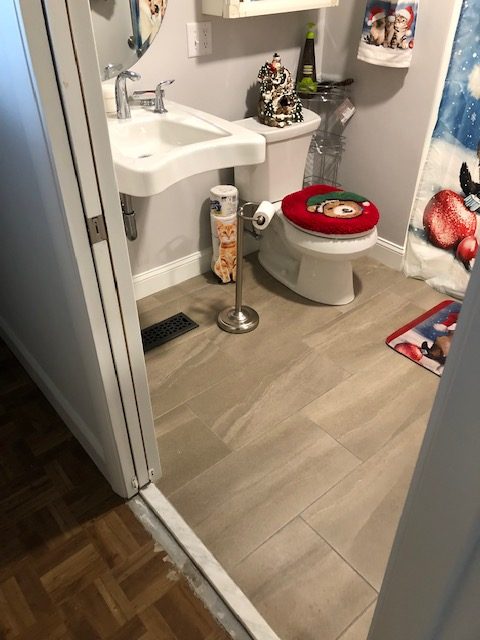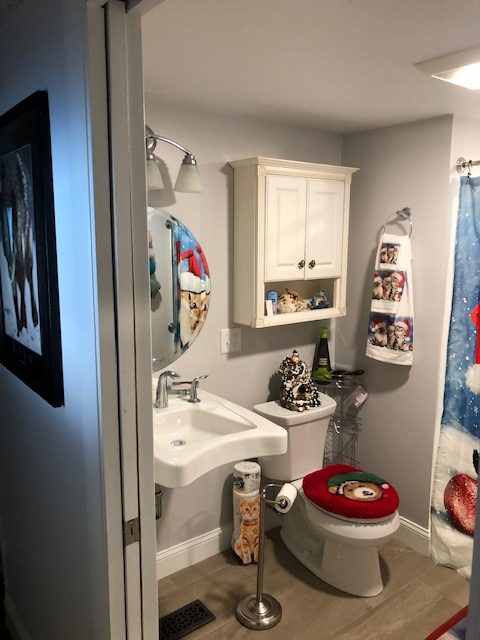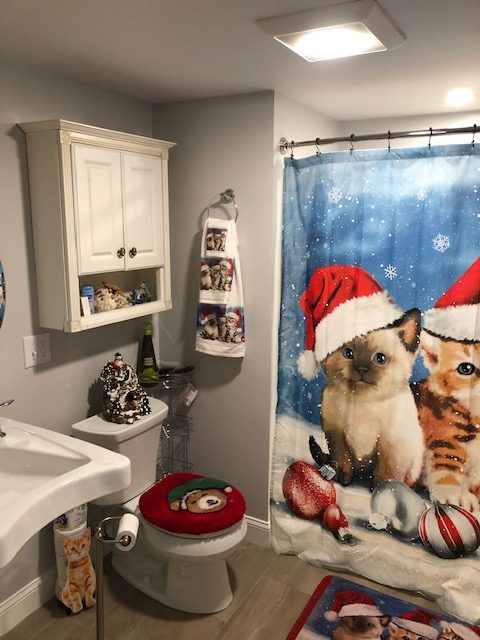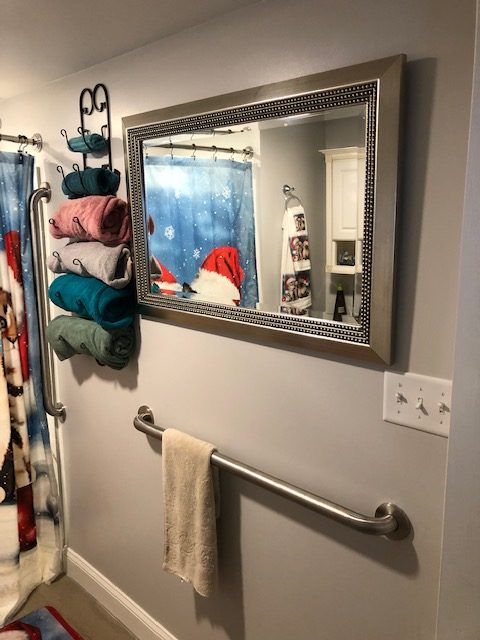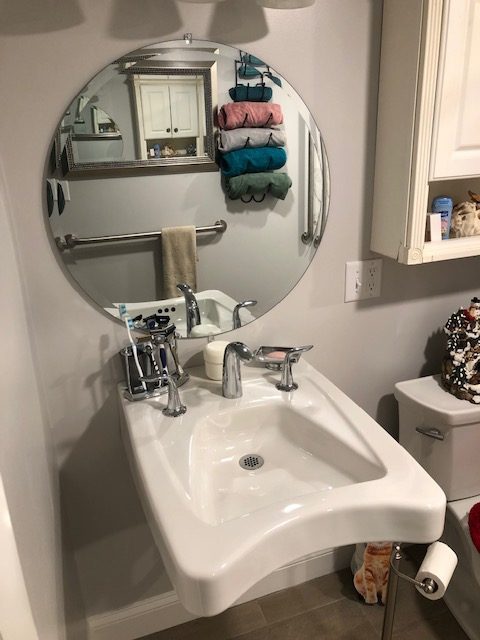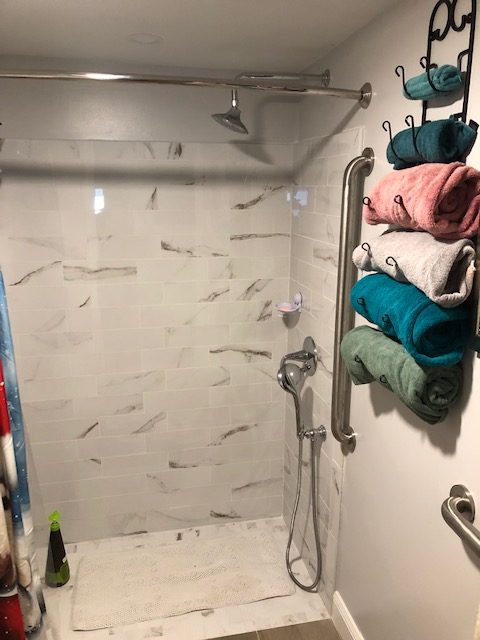Handicap Accessible Shower
I visited a homeowner in Chelmsford that wanted to turn their existing bathroom into a handicap accessible shower. The Homeowners had the unfortunate situation of having to take in their adult child who was unexpectedly involved in an auto accident which left him confined to a wheel chair.
I was their service contractor on a number of plumbing related repairs. When I was at the house they asked if I could do a bathroom remodel to handle their specific needs.
This bathroom remodel not only dealt with converting this full bathroom to a handicap bathroom but we needed to utilize the space of their mechanical room which meant we needed to down size the foot print of the standard water heater. For this we converted the storage type tank water heater to a wall mount On Demand water heater.
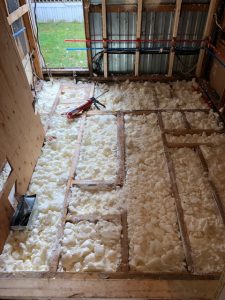
My Dear Watson Handicap Accessible Shower Rough

My Dear Watson Handicap Accessible Shower Rough2
A Curb Less Shower was urgently needed
The other specific need was a curb less shower area so they could roll their son into the shower.
All of this was also going to be performed in a Trailer style home. This as well added a unique set of challenges.
Limited space, curved ceiling framing, crawl space access to the plumbing and sealing the envelope to keep the access of rodents and air out. We needed to be conscious of water lines and plumbing freezing during the winter and meeting today’s building codes.
A Pocket Door was installed to all much bigger room to maneuver the wheel chair.
One other feature was to use a pocket door to help with the limited interior space from Hall way to bathroom. Allowing as much room to maneuver the wheel chair throughout the area.
Interior wall framing needed to be upgraded to handle a wall hung Handicap lavatory wall bracket.
This is key for the Handicap inhabitant to use the lavatory by themselves.
We, at My Dear Watson are only a phone call away.
So click www.4mywatson.com or call us today at 978-251-2994!
We are always here to help.
Wheelchair Access Shower
Making Your Bathroom ADA Compliant: A Guide to Wheelchair Accessible Showers
Are you looking for ways to make your bathroom more accessible for those with physical disabilities? If so, you’ve come to the right place! In this article, we’ll show you how to make your bathroom ADA-compliant and install showers that can be used by people in wheelchairs. We’ll talk about how important it is to follow the ADA, what steps need to be taken, and what kinds of showers are available for people who use wheelchairs. With this guide, you’ll be able to make your bathroom more accessible and comfortable for everyone. So, let’s get started!
What is ADA Compliance?
ADA compliance is a set of guidelines and standards set by the Americans with Disabilities Act (ADA) to ensure that public spaces are accessible to those with physical disabilities. For ADA-compliant bathrooms to be safe and easy for everyone to use, they need to be designed in a certain way and have certain features. These include widened doorways, accessible shower stalls, handrails, raised toilet seats, and accessible sinks. Also, for bathrooms to be ADA-compliant, they must have grab bars, shower seats, and roll-in showers for wheelchairs.
It is important to have an ADA-compliant bathroom so that everyone can feel safe and at ease. It helps get rid of any potential dangers, makes the environment more welcoming, and gives people with physical disabilities a safe place to be. With the proper planning and design, you can make your bathroom ADA-compliant and wheelchair accessible. This will make sure that all of your guests can safely and easily get to the bathroom.
Benefits of ADA Compliance
The Americans with Disabilities Act (ADA) is a law that was made to make sure that everyone has equal access to facilities, services, and products, no matter what their physical or mental abilities are. Compliance with the Americans with Disabilities Act (ADA) is an important thing to think about when designing, building, and maintaining bathrooms. This is because it makes sure that everyone has the same level of access, comfort, and independence. ADA compliance has other important benefits besides giving everyone the same access to facilities.
1- ADA compliance reduces the chance of potential legal action. By making sure your bathroom is ADA-compliant, you protect yourself from lawsuits that could be filed by people who don’t feel like they have the same access as everyone else.
2- ADA compliance lets everyone, no matter what their physical or mental limitations are, live on their own and with respect. By having a bathroom that is ADA-compliant, individuals with disabilities can maintain their independence and enjoy the same level of comfort that everyone else does.
3- ADA compliance allows you to keep your bathroom safe and secure. By making sure your bathrooms are ADA-compliant, you can make sure that everyone, no matter what their physical or mental limitations are, is safe and secure in their own homes.
Overall, it is important to think about ADA compliance when designing, building, and taking care of a bathroom. By taking the steps needed to make sure your bathroom is ADA-compliant, you give everyone the same access and comfort, protect yourself from possible legal action, and make sure your bathroom is safe and secure. By taking these steps, you can ensure that your bathroom is accessible and comfortable for everyone who uses it.
Steps to Take for ADA Compliance
Ensuring your bathroom is ADA-compliant is an important step in making your space accessible and comfortable for those with physical disabilities. By taking the right steps and putting in the right kind of shower, you can make a place where everyone feels safe and at home.
1- You should determine the necessary ADA requirements for your bathroom. This means knowing how much space is needed for accessible showers, grab bars, and other equipment, as well as how high shower seats and other amenities should be. In addition, you should confirm the type of wheelchair-accessible shower that is best for your space. There are different kinds of showers, such as roll-in showers, transfer showers, and barrier-free showers, and each has different installation and use requirements.
2- Once you have determined the necessary requirements, you can begin the installation process. This means getting the space ready, putting in the right shower equipment, and testing the shower’s safety features.
3- It’s also important to make sure that there is adequate access to any grab bars, shower seats, and other amenities.
4- Once the installation is done, you should make sure your bathroom passes the ADA test and has all the safety features it needs.
By taking these steps, you can make your bathroom ADA-compliant and create an inclusive space for everyone. With the right ADA requirements and a shower that can be used by people in wheelchairs, you can make sure that people with physical disabilities have a safe and comfortable place to stay.
Types of Wheelchair Accessible Showers
When it comes to making a bathroom accessible for those with physical disabilities, wheelchair-accessible showers are a must. These showers come in various shapes, sizes, and styles and provide a safe and comfortable bathing experience for those who use wheelchairs or other mobility devices.
There are generally two types of wheelchair-accessible showers: roll-in showers and transfer showers.
1- A roll-in shower is designed to allow a wheelchair user to enter the shower area directly and roll in. This type of shower typically has a wide entryway, a low threshold, and a shower seat that can fold up or down.
2- Transfer showers, on the other hand, are designed for those who are able to transfer out of their wheelchair and into the shower. Most of the time, these showers have a higher threshold, so the user needs a lift or another device to help them get into the shower.
No matter which type of wheelchair-accessible shower you choose, it’s important to make sure that it meets the requirements of ADA compliance. This includes having a shower floor that is level and slip-resistant, a showerhead that is low enough for a wheelchair user to reach and grab bars that are securely mounted.
Additionally, a shower seat is recommended for both types of showers. With the right safety measures in place, wheelchair-accessible showers can help make sure that everyone has a safe and comfortable bathing experience.
How do you make a wheelchair-accessible shower?
Installing a wheelchair-accessible shower is an important step in making your bathroom ADA-compliant. The Americans with Disabilities Act (ADA) requires all public accommodations, including bathrooms, to have accessible features so people with physical disabilities can use them safely and independently. This includes having a wheelchair-accessible shower.
When making a wheelchair-accessible shower, there are several important considerations to keep in mind. First and foremost, it is important to make sure the bathroom is large enough for a wheelchair to maneuver safely. Depending on the size of the bathroom, a roll-in shower or transfer shower may need to be installed. Installation of grab bars, a low threshold entrance, a shower seat, and enough ventilation are also important things to think about.
Making a wheelchair-accessible shower requires careful planning and attention to detail. At MyDearWatson Plumbing, Heating, and Cooling we take the necessary steps to make sure the shower is ADA-compliant, so you can create a bathroom that is safe and comfortable for everyone. With the right materials and installation, your shower can be used for years without any problems.
What does a wheelchair-accessible shower look like?
A shower that can be used by people in wheelchairs is an innovative way to make a bathroom easier for people with disabilities to use. It’s important to create a safe and comfortable space for all users to use, and the key to this is making sure the bathroom meets ADA (Americans with Disabilities Act) standards.
Wheelchair-accessible showers are designed to accommodate wheelchairs and other assistive devices. Generally, they have a roll-in entrance, which is an entrance into the shower that is designed to be low enough for wheelchairs to roll into the shower easily. Also, they may have a seat or chair in the shower, a handheld shower head, and grab bars in strategic places to give support and stability.
Finally, we check to see if the shower is wheelchair accessible. This means that it should be wide enough for a wheelchair to fit inside, and the shower head should be at a height that can be easily reached. Additionally, the floor should be slip-resistant to ensure safety for all users. With these measures, you can make your bathroom more accessible and comfortable for everyone.
How much space is needed for a wheelchair-accessible shower?
One important part of ADA compliance is giving wheelchair users enough space in the bathroom to move around. For a wheelchair-accessible shower, the ADA requires a 5′ x 5′ clear floor space in front of the shower to allow for entry and exit. This space should be large enough for a wheelchair to make a 180-degree turn and for a person to safely transfer from the wheelchair to the shower.
A shower that can be used by a wheelchair must have enough grab bars and seating, as well as a 5′ x 5′ clear floor space. Grab bars should be placed on the walls of the shower to provide support and stability. A shower seat should also be installed to allow for comfortable and safe use of the shower. The shower seat should be strong and safe, and it should be wide enough for a wheelchair user to sit on. Lastly, a roll-in shower should be installed to provide easier access. A roll-in shower is specifically designed to allow a wheelchair user to roll directly into the shower.
By taking the steps needed to make your bathroom ADA-compliant, you can make sure that people with disabilities can shower in a place that is easy to get to and comfortable. With the right wheelchair-accessible shower, your bathroom can become the safe and accessible space it should be.
How difficult is it to make your handicapped accessible Shower?
It can be difficult to create a handicapped-accessible shower. It requires careful planning, attention to detail, and an understanding of the regulations set forth by the Americans with Disabilities Act (ADA). When designing a handicapped-accessible shower, it is important to consider the needs of the individual with a disability and make sure that the shower is designed to meet their specific needs. This includes the size of the shower, the placement of the shower head, the design of the shower seat, and the placement of grab bars.
There are several options available when installing a wheelchair-accessible shower.
1- As we’ve already talked about, the most common type is a roll-in shower, which is made for wheelchairs and can be used with or without a shower seat. Another option is a transfer shower, which is designed to be used with a transfer chair or other device to help the user transfer from their wheelchair to the shower.
2- Grab bars can be added around the shower to make it safer and give more support. All of these features must be installed according to the ADA’s rules for them to work properly.
Making a handicap-accessible shower is a complex process, but it is an important step in making sure that everyone can enjoy a safe and comfortable shower experience. With proper planning, attention to detail, and an understanding of the ADA regulations, MyDearWatson Plumbing, Heating, and Cooling will help you create a bathroom that is ADA-compliant, comfortable, and accessible for all.
Design Considerations for Wheelchair Accessible Showers
When it comes to designing a wheelchair-accessible shower, there are many considerations to take into account. The first is ADA compliance. The Americans with Disabilities Act (ADA) says what a bathroom must have to be considered wheelchair-accessible. This includes the size and shape of the shower, the height of the showerhead, and the type of grab bar or shower seat that is needed. In addition, it’s important to create a safe and comfortable environment for those with physical disabilities. When choosing materials and fixtures, it’s important to think about how long they will last and how stable they are, as well as how slippery the shower floor will be.
Another major consideration for wheelchair-accessible showers is the type of shower to install. The most common types are roll-in showers, transfer showers, and barrier-free showers.
1- Roll-in showers are designed to allow those in wheelchairs to roll directly into the shower.
2- Transfer showers have a raised threshold that allows users to transfer from their wheelchair to a shower seat inside the shower.
3- Barrier-free showers are designed to have a low or no threshold, allowing users to move freely in and out of the shower without any restrictions.
It’s important to think about how to design wheelchair-accessible showers so that the bathroom is safe, comfortable, and up to ADA standards. By taking the needs of the users into account and choosing the right materials and fixtures, you can make a bathroom that works for everyone.
Cost of Wheelchair Accessible Showers
The cost of a wheelchair-accessible shower will vary depending on the size and type of shower you require. Generally, the cost of a basic roll-in shower will be between $6,000 and $10,000. This includes delivery and installation. If you opt for a more luxurious model with extra features, such as a hand-held shower head and grab bars, the cost can be higher. You also have to think about the cost of labor and any extra materials or supplies.
If you wish to make your shower ADA-compliant, you’ll also need to factor in the cost of handicap accessories such as grab bars, shower seats, and wheelchair ramps. Depending on the type of accessory, these can cost anywhere from $100 to $500. Additionally, you may need to make changes to the plumbing and drainage, which will also add to the cost. The cost of making a bathroom ADA-compliant ranges between $10,000 and $20,000 in general. Click here to get a quote from us. However, it’s important to remember that these costs are worth it in the long run, as they will ensure a safe and comfortable experience for all members of your family.
Maintenance and Cleaning of Wheelchair Accessible Showers
To make a bathroom ADA-compliant, it is important to keep and clean a shower that can be used by people in wheelchairs. No matter which type of shower you choose, they all need to be cleaned and maintained regularly to keep them safe and easy to use.
When it comes to maintenance, you should check the following:
1- The shower’s water pressure periodically to make sure it is not too low or too high.
2- The grab bars and shower seats for any signs of wear or damage to ensure they remain secure and safe.
3- It is important to ensure that the shower remains free from any standing water and that the floor is kept clean and dry.
When it comes to cleaning, it is important to ensure that the shower is regularly disinfected with an approved cleaner. This will help reduce the risk of bacteria and other germs that could cause health issues. Additionally, it is important to clean the grab bars and shower seats on a regular basis, as well as any other fixtures in the shower area. It is also important to ensure that the shower is always free from any items that might pose a tripping hazard. Your wheelchair-accessible shower can still be ADA-compliant and safe to use if you clean and maintain it regularly.
Safety Tips for Wheelchair Accessible Showers
The main safety protocols that we follow are installing a sturdy shower seat and making sure all surfaces are slip-resistant and properly sealed.
1- It is important to make sure that you have a sturdy shower seat installed. This will provide support for the user and prevent them from slipping or falling. It’s also a good idea to install grab bars in the shower for extra stability.
2: Slip-resistant surfaces should always be present in wheelchair-accessible showers. This is especially important for roll-in showers, as the user will be entering and exiting the shower with a wheelchair. Non-slip surfaces are a must for this type of shower, as it will help to prevent any accidents or falls.
3- It is always a good idea to make sure that the shower is properly sealed and waterproofed. This will help keep water from getting into the bathroom and causing any damage.
4- It is also important to ensure that the shower drain is working properly and that the plumbing is up to code.
These are all important safety tips that MyDearWatson takes into account when installing wheelchair-accessible showers.
Resources for ADA Compliance
When it comes to ADA compliance, the primary focus is on making sure all bathrooms are wheelchair accessible. This means replacing or fixing up doorways, installing grab bars and shower seats, and making sure the bathroom is big enough for a wheelchair-bound person to fit in. Also, the bathroom should have enough room to move around and do things like take showers and get dressed. Depending on the size of the bathroom, you may need to install a roll-in shower rather than a regular shower, as roll-in showers are far bigger and more accessible.
Once you’ve addressed the ADA compliance concerns, you’ll need to look into the type of wheelchair-accessible shower you’ll install. There are a few different varieties out there, such as roll-in showers, free-standing showers, and transfer showers. Each type is designed to facilitate easy access and maneuverability for wheelchair users. Roll-in showers are the most common type, and they feature a slightly raised, level surface that can be rolled into by a wheelchair user. Free-standing showers are another option, but they require more space, as the entire shower unit needs to be installed in the bathroom. Lastly, transfer showers are designed for those who need assistance getting in and out of the shower. They usually come with a built-in seat and adjustable water pressure.
No matter what type of shower you choose, it’s important to make sure that it meets all the ADA compliance requirements. This will ensure that your bathroom is safe and accessible for everyone. At MyDearWatson Plumbing, Heating, and Cooling, we will help you find the perfect shower for your needs.
Conclusion
In conclusion, the goal of making a bathroom that is ADA-compliant and has a shower that can be used by people in wheelchairs is an important one. It makes sure that people who can’t walk can use the bathroom and shower safely and comfortably. Installing grab bars and shower seats, as well as roll-in showers or wheelchair-accessible showers, are just a few examples of how to make a bathroom ADA-compliant. By following these steps and familiarizing yourself with the various types of wheelchair-accessible showers available, you can create a bathroom that is comfortable and safe for everyone.
Frequently Asked Questions
1- What is a Roll-in shower?
A roll-in shower is a type of wheelchair-accessible shower that is specifically designed to be safe and accessible for those with physical disabilities. These kinds of showers are made with a low threshold or ramp so that people who use wheelchairs can roll right in. Also, many roll-in showers are made with grab bars and shower seats to make sure that people with physical disabilities can shower safely without help. Roll-in showers are made to meet ADA standards and provide a safe, easy-to-use space for everyone.
Moreover, roll-in showers can be customized to fit the user’s particular needs. For instance, shower heads, faucets, and other fixtures can be moved to meet the needs of a person who uses a wheelchair. Also, shower curtains can be easily put up or taken down and replaced with ones that are the right height for the user. With this type of customization, everyone can enjoy a safe and comfortable showering experience.
Overall, roll-in showers are an excellent way to make any bathroom wheelchair accessible. Not only are they made to meet ADA compliance, but they are also customizable to the user’s particular needs. With the addition of a roll-in shower, everyone can enjoy a safe and comfortable showering experience.
2- What is a transfer shower?
A transfer shower is a bathroom designed for people with limited mobility. It has an accessible toilet and a sink that is mounted at a comfortable height so that those in wheelchairs or using other assistive devices can easily reach it. The transfer shower also features a wider entryway to allow the user to move more freely and safely while they shower. Generally, the shower should have handrails on both sides of the enclosure and a low threshold to make it easier to enter and exit the tub area. In addition, there should be slip-resistant flooring and grab bars near the showerhead, toilet, and sink. These safety features help make sure that everyone who uses the bathroom feels safe. This makes it a great choice for people with physical disabilities.
3- What is the difference between a transfer shower and a roll-in shower?
A transfer shower and a roll-in shower are two types of showers with different features. A transfer shower is designed for users who can stand and walk but have difficulty stepping over the bathtub’s edge. It allows them to easily move from the wheelchair to the shower seat without having to step over anything. On the other hand, a roll-in shower is designed for users who cannot stand or walk and must use a wheelchair at all times. This type of shower has no lip on the threshold and allows wheelchairs to roll right in, as well as providing grab bars for extra support. Also, a sink should be mounted outside of both types of showers so that people can easily use it while they’re bathing.
4- How do you make a wheelchair-accessible shower?
Making a shower that can be used by people in wheelchairs is an important step toward giving people with disabilities safe and comfortable bathroom access. The most important thing is to install a pan or wet room that allows the wheelchair to be rolled into the shower without encountering any obstacles. After the pan is in, you need to install ADA-approved fixtures like a roll-in shower or a shower for people with disabilities that has a seat. This can be expensive but is necessary in order for the shower to meet safety standards. Furthermore, you must also make sure that there is enough space on either side of the pan so that a caregiver can assist if needed. Lastly, you should install a shower spray unit and walls that are made to be used in showers. This will make the shower easier to use. By following these steps, you can create an accessible bathroom that gives people with disabilities access to a safe and comfortable shower.
5- What do you call a shower that is wheelchair accessible?
A roll-in shower, also known as an ADA (Americans with Disabilities Act) shower, is a type of wheelchair-accessible shower. This type of shower allows someone in a wheelchair to access the shower with ease. The ADA Shower features a low threshold or no threshold at all, a wide entryway, and a built-in shower chair. Additionally, the walls of the showers must have grab bars for safety and stability. An ADA roll-in shower is easy to set up and has a design that is easy to use and can be changed to fit any bathroom. It is possible to repair these types of showers if necessary, which makes them even more convenient. A shower spray head must be installed in handicap showers so that the person using the shower can change the water pressure to suit their needs. Many people don’t think much about being able to take a shower, but someone in a wheelchair needs to be able to do so in order to keep themselves clean. An ADA roll-in shower gives this kind of access and is easy to set up and modify for accessibility, making it a great choice for anyone who needs a shower that can be used by a wheelchair.
6- What does a wheelchair-accessible shower look like?
A wheelchair-accessible shower must have a walk-in opening, a roll-in shower, and an ADA roll to provide access to the shower. It must also have a shower wall with shower spray, as well as access to the bathroom floor to make it easier for wheelchair users. Showers must also have accessible ADA controls for free showers that are available for those who need them. For those who want to age in place, call us and we can install an accessible ADA-free shower with all the necessary components. This includes the roll-in showers, the shower wall, and the built-in shower controls. With these components combined, you can have a wheelchair-accessible shower that is safe and convenient for all users.
7- How much space is needed for a wheelchair-accessible shower?
When it comes to wheelchair-accessible showers, the amount of space needed depends on the type of shower you choose. If you opt for a bathtub with a roll-in shower, you will need at least 5 feet of space to provide adequate ADA roll-in access to the shower. Showers must also have a shower spray and diverter valve, as well as enough room for someone to walk in safely. For those wanting a more permanent solution, there are shower kits available that include everything needed for a shower installation. These kits can also come with a fixed shower designed specifically for wheelchair users and may require some additional space for the toilet seat or bench seat in the shower. Finally, if you want to install your own custom-built wheelchair-accessible shower, make sure that you allow enough space for proper installation before starting the project.
8- What is a Roll-in shower?
A roll in shower, or roll-in type shower, is a type of shower designed for people using a wheelchair or other mobility device to easily access the shower. It must have a level entry with no steps and a shower spray. The ADA’s (Americans with Disabilities Act) roll-in showers are larger than walk-in showers and provide more room for someone to move around in a wheelchair. The floor should be completely flat, and bars should be installed in the walls of the shower so that someone can hold onto them while they maneuver the wheelchair into the shower area. These types of showers can greatly improve the quality of life for those who need this type of access to a shower. Since it is a bit harder to install than other types of showers, it is important to hire a contractor with the experience to make sure it is done right.
9- How important is accessibility when it comes to taking a shower for a handicapped person?
Accessibility is incredibly important when it comes to taking a shower for a handicapped person. The showers must have a shower head that is easy for the person to reach and use on their own. The ADA says that showers should be made for people with limited mobility. For example, a standard roll-in shower or a rolling shower could be installed. It’s also important that the shower is level with the floor so that wheelchairs can easily maneuver into it. For new showers, there should be support bars around the shower and tub enclosures. For existing showers, there should be no curbs. With these things in place, people with disabilities can take a safe and comfortable shower without help.
10- How difficult is it to make your handicap-accessible Shower?
Making a handicap-accessible shower is not an easy feat, as there are many important factors to consider. For starters, the shower must have a shower spray unit with a hose that can be used within the shower. The best option for making your shower handicap accessible is to install a curbless shower, which means that the lip of the shower should be no higher than 48 inches. This allows handicapped individuals to easily enter and exit the shower without any assistance. Also, it’s important to put in a spray unit with a hose that can be used on its own, so that people with disabilities can easily turn on the water and adjust it as needed without help. Lastly, when installing a handicap-accessible shower in an assisted living facility, it is important to make sure that all safety features are installed correctly and are kept up to date. Taking all of these factors into account, creating a handicap-accessible shower is not an easy task, but it can be very rewarding for those who require it.
9- How important is it to make the bathroom sink accessible?
Having a bathroom sink that is accessible and easy to use is essential for everyone. It should be completely independent of the rest of the bathroom, so it can be used without having to worry about reaching or manipulating other fixtures. To make the sink accessible, it should be mounted on the wall instead of situated on the floor. This way, individuals with limited mobility will not have to worry about bending over or getting down on their knees in order to wash their hands. Also, mounting the sink makes sure that it is at a good height for everyone who uses it. Making the sink accessible is an important part of ensuring safety and making sure everyone can comfortably use it. Not only does this benefit people with disabilities or limited mobility, but also those who are taller or shorter than average. Accessible sinks also help keep people clean by making it easier and more comfortable for everyone to wash their hands.
Table of Content



